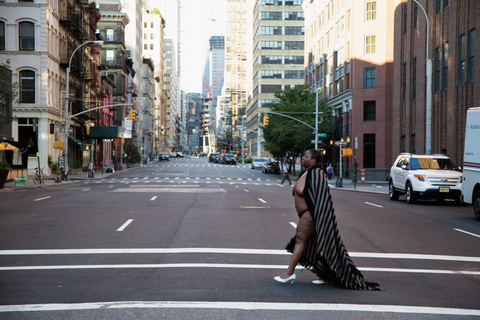
Coulson Family, 2008 © Deana Lawson
Deana Lawson often begins her public lectures by projecting a picture of her mother, an image created around 1988 with the help of then-nine-year-old Lawson and her twin sister, Dana. Lawson’s mother, positioned at the middle of the frame, reclines languidly in the family’s living room, wearing a short, dark, form-fitting dress, gazing directly into the camera lens. The tidy room is color coordinated, with decorative touches that include a statue of an elephant, leafy plants, and framed family photographs on the coffee table. Lawson says that the photograph was made for a calendar that her mother made as a gift to the artist’s father.
The portrait might be considered a precursor to Lawson’s later artistic endeavors—it touches on several themes that are at the heart of the artist’s work today: family relationships, love, and narratives of fantasy and desire created through picture making. It is a highly composed scene featuring, at the center, a Black figure gazing directly into the lens; the environment, charged with intimacy, is a precise and detailed depiction of domestic space; moreover, the presence of the framed family photographs in the picture underscores the primacy of kin in the artist’s ethos. In short, the photograph embodies many of the primary elements of Lawson’s enduring visual lexicon. For this artist, family and photography are always inexorably linked.

Nation, 2018 © Deana Lawson
Consider another image: a self-portrait of Lawson posing under a tree with her view camera. This formal portrait, made in 2012, is often used in the promotion of Lawson’s lectures; it is, in a sense, her official self-depiction. As such, this photograph might seem at odds with the casually intimate picture of the artist’s mother, but both images suggest the multivalent photographic languages that are at play in Lawson’s work. The choice to include the bulky view camera—an apparatus that dates back to the time of photography’s invention—as part of her official portraiture indicates how closely tied Lawson is to the medium’s material conditions, and to the development of photographic technology itself. The view camera is selected by many portraitists and photography purists because it affords the ability to create richly detailed and razor-sharp images. Not only is it Lawson’s camera of choice, she teaches others how to use it; her close engagement with this technology is an important part of her identity. It also distinguishes her from her generation of peers, most of whom have taken up digital and handheld technologies. At the same time, Lawson’s interest in the vernacular of family snapshots (witness the framed photographs that appear on walls or propped on tables in many of her staged scenes) creates a matrix of references that sustains the dynamic tension in her work. This dichotomy between the formal and the casual plays out in other ways too: her pictures’ large scale (prints are often more than four feet tall or wide) imbues them with a monumental, studio-portrait quality; yet the interiors she depicts, her sitters’ occasional states of nudity, and the expressions of undisguised desire or tenderness between them all suggest the carefree spontaneity of snapshots. Thus, even while Lawson is devoted to the view camera and to the formality associated with it, incongruously (or perhaps not), she is also taken by the candid tone of home pictures.

Hair Advertisement, 2005 © Deana Lawson
Photography is often considered and discussed reductively, in terms of binary classifications: color versus black and white, landscape versus portrait, documentary versus staged (or versus art), analogue versus digital, representation versus abstraction. In fact, the medium, young as it is, has always been open to hybridity, capable of embracing many roles. Enriched by a range of backstories—photographic histories, feminist histories, Black histories—Lawson’s work is also informed by her life experiences, pop culture, her interest in both spirituality and photographic technology. Singular in its vision, profoundly complex in its ideas, her work has the capacity to haunt those who encounter it. Her pictures possess an intimacy and an immediacy that can be both startling and uplifting. In occupying a space of multiplicity and ambiguity,1 the work of this relentlessly adventurous artist engages the complications and the expansiveness of our moment.
Lawson’s photographs are visual testimonies in which relationships, sexuality, and life cycles are essential motifs, and of course the notion of family encapsulates all these things. For this artist, however, that notion is not limited to her own experience or her personal relations; indeed, she is willing to enter the realm of invention—casting, costuming, staging—in order to explore it. “I love to look at family albums, even other people’s,” she says. “I love the gap or space between the moment and what is the reality, what is left out and what is kept. Looking at old photos of my aunts and my mom—celebrations, cookouts—affected my intention in terms of wanting the image to feel familiar even if the subjects weren’t related. I want that feeling.”2

Black Gold ("Earth turns to gold, in the hands of the wise", Rumi), 2021 © Deana Lawson
In the digital age, even as photographic documentation is more ubiquitous than at any other time in the medium’s history, the family album, as such, is facing obsolescence. And yet the established conventions and tropes of the album play a central role in Lawson’s aesthetic—the casual gatherings, the living-room rituals, the easy, at-home connection between sitter and photographer. These tropes are, however, transmuted by this photographer: she looks for subjects (they are often strangers to her), she may or may not decide what they will wear, how they are posed, and where they will be photographed, in order to create what she describes as “a mirror of everyday life, but also a projection of what I want to happen.”3 At the same time, she welcomes the active participation of her sitters, and remains open to chance encounters and gestures.
In all this, Lawson poses challenges to the prevailing conventions of picturing family life. “It’s about setting a different standard of values,” she says, “and saying that everyday black lives, everyday experiences, are beautiful and powerful.”4 Thus, playing on the very vernacular traditions that have long restricted them, Lawson refutes circumscribed notions about gender, family, and race. Significantly, the artist doesn’t merely “picture” families, but produces complicated familial narratives, and indeed, pokes at the concept of family itself.5
Excerpt from Eva Respini’s essay ‘Deana Lawson’s Family Album’, from Deana Lawson ed. by Peter Eleey & Eva Respini (MACK, 2021).
Notes
- In this context, I also point to Darby English’s notion of “ambiguity” in Black represen- tational space. “Ambiguity,” he writes, “runs counter to the presumption that black artists and their work are transparent to social identity.” English, How to See a Work of Art in Total Darkness (Cambridge, MA: MIT Press, 2007), 13.
- Deana Lawson, interview with Sabine Mirlesse, Whitehot (November 2011); whitehot- magazine.com/articles/in-conversation-with-deana-lawson/2403.
3. Deana Lawson, in Mary Dellas, “An Artist Explains Her Staged Photos of Black Intimacy,” The Cut (March14, 2018); thecut.com/2018/03/deana-lawson-interview.html. - Ibid.
5. Prominent among contemporary photographers who have carefully navigated the idea and representation of family is LaToya Ruby Frazier. See Frazier, The Notion of Family (New York: Aperture, 2014), in particular Laura Wexler’s essay “A Notion of Photography” in that volume (143–47).
Faux leather bound hardback with printed tip in and embossed text.
24 x 29cm, 144 pages
ISBN 978-1-912339-98-3
November 2021
€40 £35 $40
Add to cart





